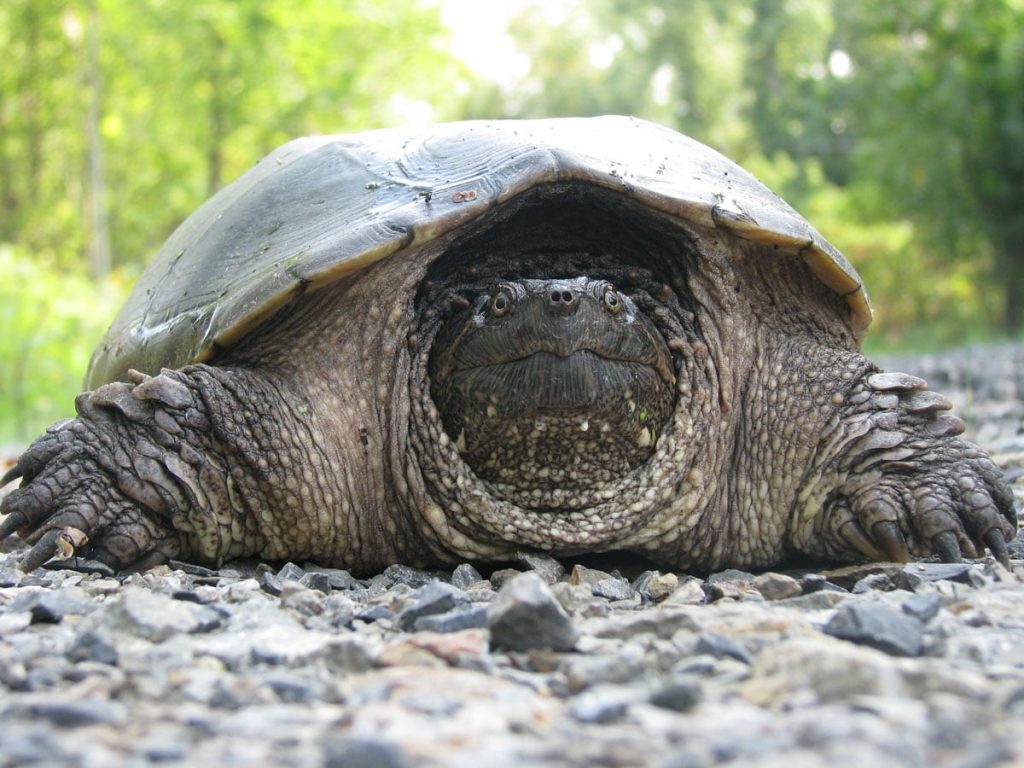Kanien’kehá:ka culture is integral and inherently linked to the work that we do at Kahnawà:ke Environment Protection Office. The Ohén:ton Karihwatéhkwen (which in our language means “the words that come before all else”) was given to the Rotinonhsón:ni as a reminder that humans share the important responsibility to ensure that the cycles of life continue. These words of thanksgiving are expressed to bring our minds together and to offer our gratitude to all the different parts of creation that continue to fulfill their duties in the natural world.
We coexist with all our brothers and sisters in the natural world and unfortunately human disturbances to the environment are inevitable. However, we have the responsibility to find sustainable ways to develop and live our lives so we can avoid and minimize disturbances to the natural world.
At the Kahnawà:ke Environment Protection Office, our actions and recommendations are guided by our culture and the goal of protecting our environment for the future generations. We strive to steer the community towards sustainable ways of developing and sustainable lifestyles. This is generally done in a priority sequence:
- The first priority is to avoid disturbances to the natural environment;
- If this is not possible, we can assist in finding ways to minimize disturbances;
- We also work to restore or enhance habitats that have been disturbed so that a diversity of plants and animals can thrive once again.

Here are some Kanien’kéha (Mohawk) words you can learn about our environment in Kahnawà:ke:
Our language is descriptive and provides us with the foundation of our worldview. The forces of colonization have had devastating impacts on our language, which is at risk of being lost. Kahnawà:ke, like many other Onkwehón:we (Mohawk word for “Original People”) communities, has initiated many programs and activities to bring our language back to life in our homes, schools, at work, and around the community.
Kahnawà:ke Environment Protection Office – Kahnawà:ke Iakwatonhontsanónhnha tsi Iehiatónhkhwa
Environment Protection
Environment Protection
- Iakwatonhontsanónhnha – Ia-kwa-ton-hon-tsa-nónhn-ha – We all mind her, the Earth
- Rontonhontsanónhnha – Ron-ton-hon-tsa-nónhn-ha – They all mind her, the Earth
- Ionkhi’nisténha tsi Iohontsá:te – Ion-khi’-ni-stén-ha tsi Io-hon-tsá:-te – Our Mother the Earth
- Sherihwakwénienst ne Ionkhi’nisténha tsi Iohontsá:te – She-rih-wa-kwé-nienst ne Ion-khi’-ni-stén-ha tsi Io-hon-tsá:-te – Respect her, our Mother the Earth
- Tóhsa enhskaré:wahte ne Ionkhi’nisténha tsi Iohontsá:te – Tóh-sa enh-ska-ré:-wah-te ne Ion-khi’-ni-stén-ha tsi Io-hon-tsá:-te – Don’t hurt her, our Mother the Earth
- Tóhsa satié:sat ne ohné:kanos – Tóh-sa sa-tié:-sat ne oh-né:-ka-nos – Don’t waste water
Wildlife in Kahnawà:ke
Wildlife in Kahnawà:ke
- Kentsonhshón:’a – Ken-tsonh-shón:-’a – Fish (plural)
- Kéntson – Kén-tson – Fish
- Kanión:ta – Ka-nión:-ta – Minnow
- Onawa’tstokón:ha – O-na-wa’-tsto-kón:-ha – Bullhead
- Oiahè:ta – O-ia-hè:-ta – Perch
- Oneniokón:ha – O-nen-io-kón:-ha –Rock Bass
- Teiotién:taron – Te-io-tién:-ta-ron – Sturgeon
- Tiawerón:ko – Tia-we-rón:-ko –Eel
- Otskwà:rhe – Ots-kwà:r-he – Frog
- Tsikenitshehwèn:ta – Tsi-ke-nit-sheh-wèn:-ta – Tadpole
- Tsikhnennà:tak – Tsikh-nen-nà:-tak – Toad
- Ò:niare – Ò:-nia-re – Snake
- Tsikenontsísta – Tsi-ke-non-tsís-ta – Salamander
- A’nó:wara – A’-nó:-wa-ra – Turtle
- Ohsohkwa’kéha a’nó:wara – Oh-soh-kwa’-ké-ha a’-nó:-wa-ra – Painted turtle
- Kaniáhton a’nó:wara – Ka-niáh-ton a’-nó:-wa-ra – Snapping turtle
- Otsi’ten’okón:’a – O-tsi’-ten’-o-kón:-’a – Birds
- Tsítha – Tsí-tha – Bird
- Kanatakón:ha – Ka-na-ta-kón:-ha – Sparrow
- Ken’tarakonhá:ka – Ken’-ta-ra-kon-há:-ka – Swallow
- Kwareró:ha – Kwa-re-ró:-ha – Barn Owl
- Tsistékeri – Tsi-sté-ke-ri – Great Horned Owl
- Tsohwà:tstaka’we – Tsoh-wà:ts-ta-ka’-we – Seagull
- Tawístawis – Ta-wís-ta-wis – Snipe
- Tonniatarèn:ton – Ton-nia-ta-rèn:-ton – Loon
- Tsiktsiré:re – Tsik-tsi-ré:-re – Chickadee
- Tsiktsinén:nawen – Tsik-tsi-nén:-na-wen – Butterfly
Plant Life in Kahnawà:ke
Plant Life in Kahnawà:ke
- Okwire’shón:’a – O-kwi-re’-shón:-’a – Trees
- Okwí:re – O-kwí:-re – Tree
- Ónerahte – Ó-ne-rah-te – Leaf
- O’wá:tsiste – O’-wá:-tsis-te – Bark
- Ohskwè:ia – Oh-skwè:-ia – Bud on a tree
- Atiehwà:ta – A-tieh-wà:-ta – Butternut tree
- Ononhkwa’shón:’a – O-nonh-kwa’-shón:-’a – Medicines
- Iokhahon’kó:wa – Io-kha-hon’-kó:-wa – Wild garlic/leek
- Iohséhton – Ioh-séh-ton – May Apple
- Tekaren’tó:ken – Te-ka-ren’-tó:-ken – Ginseng
- Onó:ta – O-nó:-ta – Cattails
- Káneron – Ká-ne-ron – White Ash
- Éhsa – Éh-sa – Black Ash
Habitats in Kahnawà:ke
Habitats in Kahnawà:ke
- Kahnekarónnion – Kah-ne-ka-rón-nion – All the waters
- Kaná:waien – Ka-ná:-wa-ien – Swamp
- Kanawakónhson – Ka-na-wa-kónh-son – In the wetlands
- Kahionhatátie – Ka-hion-ha-tá-tie – Creek, stream
- Kaniataratátie – Ka-nia-ta-ra-tá-tie – River
Species at Risk
Species at Risk
- Ionahtonhátie – Io-nah-ton-há-tie – They are disappearing
- Iótteron ne Akónhton – Iót-te-ron ne A-kónh-ton – It’s disturbing that they may disappear (species at risk)
Invasive Species
Invasive Species
- Wateronta’wénthos Otsi’nón:wa – Wa-te-ron-ta’-wén-thos O-tsi’-nón:-wa – Emerald Ash Borer
Climate Change
Climate Change
- Teiottenionhátie’ tsi niiorihò:ten’ nonhwéntsa’ – Te-iot-ten-ion-há-tie’ tsi ni-io-ri-hò:-ten’ nonh-wén-tsa’ – Climate Change
- Aontaka’seronnénhton’ – A-on-ta-ka’-se-ron-nénh-ton’ – Mitigation
- Entsitewarèn:ha’ – En-tsi-te-wa-rèn:-ha’ – Adaptation
- Ionkwa’nikonhratshá:ni – Ion-kwa’-ni-konh-rat-shá:-ni – Resilience
- Ientewatahsónteren’ – Ien-te-wa-tah-són-te-ren’ – Sustainability
- Kà:ron’ nitio’shatstenhserá:ien – Kà:-ron’ ni-tio’-shat-stenh-se-rá:-ien – Vulnerability
- Onhwentsakwé:kon enwa’taríha’te’ – Onh-wen-tsa-kwé:-kon en-wa’-ta-rí-ha’-te’ – Global warming